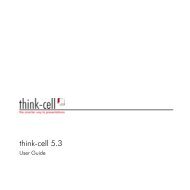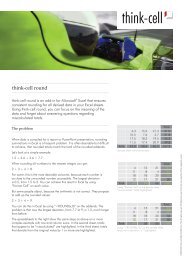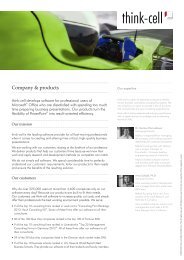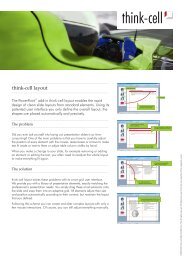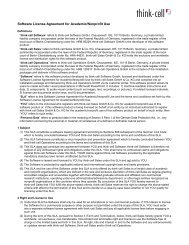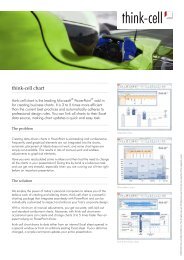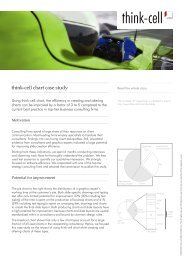think-cell technical report TC2003/01 A GUI-based Interaction ...
think-cell technical report TC2003/01 A GUI-based Interaction ...
think-cell technical report TC2003/01 A GUI-based Interaction ...
You also want an ePaper? Increase the reach of your titles
YUMPU automatically turns print PDFs into web optimized ePapers that Google loves.
5.1 Program Architecture IMPLEMENTATION<br />
levels. The union set of all UI objects is then returned.<br />
Figure 40 gives an idea of how user interaction propagates through the system<br />
and finally generates appropriate on-screen feedback. When the framework inter-<br />
cepts a mouse event message, such as ButtonDown, the message gets forwarded to<br />
the responsible document window and its UI objects. Each UI object has to make<br />
a decision if it is concerned by that mouse action, depending on the current mouse<br />
pointer location and possibly other UI objects concurrently capturing the mouse.<br />
If appropriate, the UI object puts its respective visual elements into another state<br />
– say, highlight – to reflect its responsiveness. Moreover, the UI object that was hit<br />
calls its own OnClick() method that finally applies the intended changes to the data<br />
model. Meanwhile, the visual element has notified the framework of the invalidation<br />
of the screen region where a change in the UI occurred.<br />
Depending on the effect that the mouse interaction had on the underlying data<br />
model, the smart grid, its shapes and its UI objects may explicitly be called to<br />
update themselves. The propagation of UpdateShapes() and UpdateUI() messages<br />
are not reflected in the sequence diagram; they take similar paths as the CreateUI()<br />
message in figure 39. At some point in time, there will be a Paint() message<br />
generated from the framework, which causes the visual elements to update their<br />
texture mapping with regard to current document and screen coordinates, and<br />
finally reflects the internal state on the screen.<br />
User<br />
Mouse event<br />
visual feedback<br />
... ButtonDown()<br />
... Paint()<br />
:CPPTDocWnd<br />
ButtonDown()<br />
Paint()<br />
:CUIObject<br />
Highlight()<br />
Paint()<br />
:CVisualElement<br />
OnClick()<br />
SetDirtyRect(...) ...<br />
Modify()<br />
BuildScreenPoints()<br />
TextureMapping(...)<br />
Figure 40: Processing of user input and generation of visual feedback<br />
75<br />
...<br />
:CFeature



